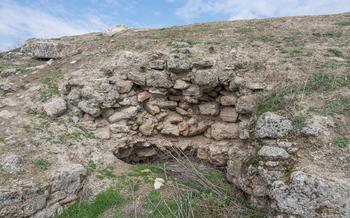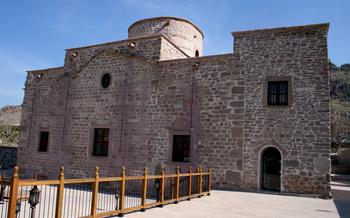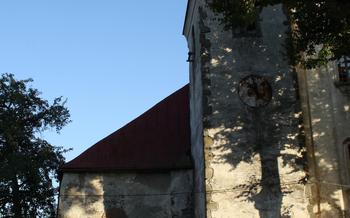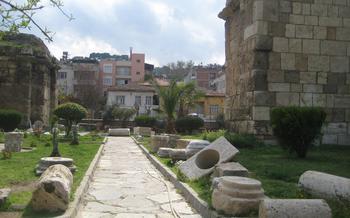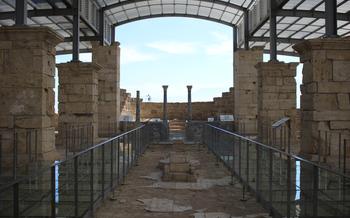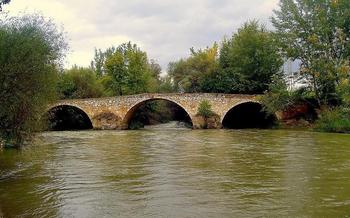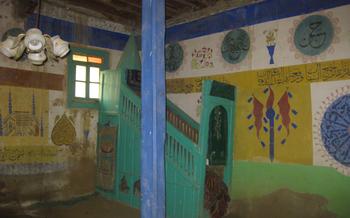
Eskihisar Church
- Location and Accessibility
- Architectural Features
- Interior Decorations
- Historical Importance
- Religious Significance
- Restoration and Preservation
- Visiting Hours and Admission
- Photography and Videography
- Dress Code and Etiquette
- Accessibility for Disabled Visitors
- Nearby Attractions
- Local Cuisine and Restaurants
- Local Festivals and Events
- Insider Tip: Discover the Hidden Gem of Eskihisar Village
Location and Accessibility
Eskihisar Church is situated in the charming village of Eskihisar, approximately 10 kilometers northwest of Denizli city center. To reach the church, visitors can take a short bus ride or drive along the scenic countryside roads. The journey offers breathtaking views of the surrounding mountains and valleys, making it a pleasant experience in itself.
The church is easily accessible by car, with ample parking space available in the vicinity. Visitors can also opt for a leisurely walk from the village center, enjoying the tranquil atmosphere and admiring the traditional Turkish architecture along the way.
Eskihisar Church is wheelchair accessible, ensuring that visitors with disabilities or special needs can explore the church's interior and admire its architectural features. Ramps and designated parking spaces are available for the convenience of visitors with mobility impairments.
Architectural Features
Eskihisar Church stands as a testament to the architectural prowess of the Byzantine Empire. Its design is a blend of traditional Byzantine elements with regional influences, resulting in a unique and captivating structure. The church's most striking feature is its impressive dome, which dominates the skyline and symbolizes the divine presence. Supported by four massive pillars, the dome creates a sense of awe and grandeur, drawing the eyes upward towards the heavens.
The church's interior is characterized by elegant arches that support the walls and create a sense of spaciousness. These arches are not merely structural elements but also decorative features, adding a touch of sophistication to the overall design. The walls are adorned with intricate carvings and bas-reliefs depicting biblical scenes and figures, showcasing the artistic skills of the Byzantine craftsmen.
The use of stone and brick in the construction of Eskihisar Church adds to its durability and longevity. The sturdy walls have withstood the test of time, preserving the church's original form and structure despite centuries of weathering and seismic activity. The combination of these materials creates a harmonious blend of strength and aesthetics, enhancing the church's architectural significance.
Interior Decorations
The interior of Eskihisar Church is a testament to the artistic prowess of the Byzantine era. Intricate frescoes and mosaics adorn the walls and ceilings, depicting religious scenes, biblical figures, and saints. The vibrant colors and expressive brushstrokes bring the stories to life, creating a sense of awe and reverence within the sacred space.
The frescoes, masterfully executed, showcase a range of techniques, from delicate line work to bold, sweeping strokes. The artists' attention to detail is evident in the intricate facial expressions, flowing garments, and symbolic gestures of the depicted figures. Each fresco tells a story, illustrating moments from the life of Christ, the Virgin Mary, and various saints.
The mosaics, composed of thousands of tiny colored tiles, add a touch of brilliance and luminosity to the church's interior. They depict geometric patterns, floral motifs, and religious iconography. The play of light on the mosaic surfaces creates a shimmering effect, enhancing the sacred atmosphere of the church.
The combination of frescoes and mosaics creates a visual feast for visitors, transporting them back in time to the vibrant artistic traditions of the Byzantine Empire. The interior decorations of Eskihisar Church stand as a testament to the enduring power of religious art and its ability to inspire and uplift the human spirit.
Historical Importance
Eskihisar Church holds immense historical significance in the context of the Byzantine Empire, serving as a prominent religious and cultural center in Denizli. During the Byzantine period, the church played a pivotal role in religious ceremonies, rituals, and festivals, fostering a deep sense of community and spirituality among the local Christian population. As a testament to its enduring legacy, the church hosted significant religious events and festivals that attracted pilgrims and worshippers from across the region. Furthermore, Eskihisar Church was closely intertwined with political and social events that shaped the history of Denizli and the surrounding area. Its involvement in these events, including significant historical figures and developments, contributed to the church's enduring historical importance, making it a valuable site for understanding the region's rich past.
Religious Significance
Eskihisar Church holds immense religious significance for Christians in Denizli and beyond, serving as a symbol of their faith and devotion. As an active place of worship, the church has played a crucial role in spreading Christianity throughout the region. Its dedication to a specific saint or religious figure attracts pilgrims and visitors who seek spiritual guidance and blessings. The church's involvement in religious ceremonies, rituals, and festivals strengthens the bond among the Christian community, fostering a sense of unity and belonging. Its rich history and association with significant religious events contribute to its enduring religious importance, making it a sacred destination for many believers.
Restoration and Preservation
Eskihisar Church has undergone several restoration and preservation efforts throughout its history, ensuring its structural integrity and preserving its historical value. In the 19th century, the church underwent extensive renovations, which included repairing the dome, reinforcing the walls, and restoring the interior decorations. These efforts aimed to maintain the church's original features while adapting it to modern conservation standards.
In recent years, local authorities and organizations have collaborated to undertake further restoration projects. These projects focused on addressing structural issues, such as cracks and water damage, and conserving the church's unique frescoes and mosaics. The restoration team employed traditional techniques and materials to ensure the authenticity of the repairs and preserve the church's historical character.
The ongoing conservation efforts at Eskihisar Church are crucial for safeguarding its heritage for future generations. Visitors can contribute to these efforts by respecting the church's historical significance and adhering to conservation guidelines. They can also support ongoing projects by making donations or volunteering their time.
Visiting Hours and Admission
Visiting Eskihisar Church is a free and enriching experience. The church's doors are open to visitors from 9:00 AM to 5:00 PM daily. Visitors are welcome to explore the church's interior, admire its architectural features, and learn about its fascinating history. Guided tours are available upon request, offering a deeper understanding of the church's significance and symbolism. For those interested in capturing the church's beauty through photography or videography, it is important to respect the sacred nature of the space and minimize disruptions to religious activities. Flash photography is not permitted, and visitors are kindly requested to maintain a respectful silence while inside the church.
Photography and Videography
Visitors to Eskihisar Church are welcome to take photographs and videos for personal use, as long as they respect the sacred nature of the church and minimize disruptions to religious activities. Flash photography and tripods are not permitted inside the church to preserve the integrity of the artwork and decorations. The best spots for taking photos or videos are in the nave, where visitors can capture the grandeur of the architecture and the intricate details of the frescoes. Professional photography or videography services are available upon request, and visitors can inquire with the church staff for more information.
Dress Code and Etiquette
When visiting Eskihisar Church, it is important to observe appropriate dress and etiquette as a sign of respect for the sacred nature of the site. Visitors should dress modestly and avoid wearing shorts, tank tops, or revealing clothing. It is customary for women to cover their heads with a scarf or shawl when entering the church.
It is important to be mindful of your behavior within the church and avoid talking loudly or disturbing others who may be praying or meditating. Photography and videography are allowed, but visitors should be discreet and avoid using flash or tripods that may disrupt religious activities.
Visitors should also be mindful of local customs and traditions. For example, it is customary to greet the priest or other religious officials with a handshake or a nod of the head. It is also important to avoid touching or leaning on religious icons or other sacred objects within the church.
By following these simple guidelines, visitors can ensure that they have a respectful and enjoyable experience when visiting Eskihisar Church.
Accessibility for Disabled Visitors
Eskihisar Church welcomes visitors with disabilities and offers various accessibility features to ensure a comfortable and enjoyable experience. The church is equipped with ramps and elevators, allowing wheelchair users and visitors with mobility impairments to access all areas of the building, including the main sanctuary, chapels, and viewing platforms. Designated parking spaces for visitors with disabilities are available near the church entrance, making it convenient for them to arrive and depart. Additionally, the church provides assistive devices such as wheelchairs and hearing loops for visitors with hearing impairments. Visitors with visual impairments can request tactile maps or guided tours with detailed descriptions of the church's architectural features and interior decorations. The church staff is well-trained and always ready to assist visitors with disabilities, ensuring that everyone has a meaningful and accessible experience at Eskihisar Church.
Nearby Attractions
In the vicinity of Eskihisar Church, visitors can discover a wealth of other captivating attractions that further enrich their exploration of Denizli's rich history and cultural heritage. Within easy reach of the church, the following destinations are well worth considering:
-
Pamukkale: Located approximately 19 kilometers from Eskihisar Church, Pamukkale is a natural wonder renowned for its cascading white travertine terraces and thermal hot springs. Visitors can marvel at the stunning landscape, indulge in a rejuvenating dip in the warm waters, and explore the ancient ruins of Hierapolis, a Greco-Roman city that once stood in the area.
-
Hierapolis Archaeological Museum: Situated adjacent to the Pamukkale travertines, the Hierapolis Archaeological Museum houses an impressive collection of artifacts unearthed from the ancient city. Visitors can admire well-preserved sculptures, mosaics, inscriptions, and other relics that offer a glimpse into the rich history and culture of Hierapolis.
-
Karahayit Hot Springs: Just 8 kilometers from Eskihisar Church, Karahayit is famous for its therapeutic hot springs. Visitors can immerse themselves in the soothing waters and relax amidst the tranquil surroundings, enjoying the restorative benefits of the mineral-rich springs.
-
Denizli Cable Car: For a breathtaking panoramic view of Denizli and the surrounding region, visitors can take a ride on the Denizli Cable Car. The cable car connects the city center with the Bozdağ Ski Resort, offering stunning aerial vistas along the way.
-
Kaklık Cave: Approximately 30 kilometers from Eskihisar Church, Kaklık Cave is a natural wonder with an intriguing history. Visitors can explore the cave's vast chambers, adorned with stalactites and stalagmites, and learn about the archaeological discoveries made within its depths.
These nearby attractions provide visitors with an opportunity to delve deeper into the region's natural and cultural treasures, creating a well-rounded and memorable travel experience in Denizli.
Local Cuisine and Restaurants
After exploring the historical wonders of Eskihisar Church, take a culinary journey and savor the delectable flavors of Denizli's local cuisine. Indulge in traditional Turkish dishes that showcase the region's rich culinary heritage.
For an authentic dining experience, head to "Lokanta Birinci Sınıf," located just a short walk from the church. This family-run eatery serves up mouthwatering kebabs, freshly baked pide, and tantalizing mezes that will delight your taste buds.
Don't miss the opportunity to try Denizli's specialty dish, "keşkek," a hearty stew made from wheat, meat, and chickpeas, slow-cooked to perfection. Pair your meal with a glass of refreshing ayran, a yogurt-based beverage that perfectly complements the flavors of Turkish cuisine.
If you're looking for a more upscale dining experience, "Zeytindalı Restaurant" offers a sophisticated ambiance and a menu featuring modern interpretations of Turkish classics. Savor the flavors of grilled seafood, succulent lamb chops, and exquisite desserts that will leave you wanting more.
For a quick bite or a sweet treat, stop by one of the many cafes or patisseries in the area. Indulge in flaky börek, freshly baked simit, or tantalizing Turkish delight, all while enjoying the lively atmosphere of Denizli's streets.
Remember, when dining in Denizli, don't be afraid to embrace the local customs. Turks take great pride in their hospitality and love sharing their culinary treasures with visitors. So sit back, relax, and let the flavors of Denizli transport you to a world of culinary delight.
Local Festivals and Events
Denizli is a vibrant city with a rich cultural heritage, and visitors can immerse themselves in its traditions by attending local festivals and events. The annual Denizli Grape Harvest Festival, held in September, showcases the region's viticulture and offers visitors the chance to sample local wines, enjoy grape-themed activities, and participate in traditional grape stomping. The Denizli Pomegranate Festival, held in November, celebrates the region's renowned pomegranates, featuring a variety of pomegranate-based products, culinary delights, and cultural performances.
For those interested in history and culture, the Denizli Archaeology Festival, held in June, showcases the city's rich archaeological heritage, featuring exhibitions, lectures, and guided tours of ancient sites. The Denizli Carpet Festival, held in October, celebrates the city's long-standing tradition of carpet weaving, with displays of intricate carpets, demonstrations by skilled weavers, and opportunities to purchase handmade carpets.
To make the most of your experience at local festivals or events, it's advisable to research the dates and locations in advance, as they can vary from year to year. Dress comfortably and be prepared for crowds, especially during popular festivals. Embrace the opportunity to interact with locals, learn about their customs, and enjoy the festive atmosphere that Denizli has to offer.
Insider Tip: Discover the Hidden Gem of Eskihisar Village
Just a short walk from Eskihisar Church, nestled among the charming cobblestone streets, lies a hidden gem waiting to be discovered: the traditional Turkish village of Eskihisar. Step into this enchanting village and immerse yourself in the authentic culture and lifestyle of the locals. Explore its narrow alleys, admire the preserved Ottoman-era houses, and soak in the warm hospitality of the villagers. Don't miss the opportunity to savor delicious homemade Turkish delights and traditional cuisine at one of the local cafes or restaurants. Eskihisar village offers a unique glimpse into Turkey's rich history and heritage, making it a must-visit for travelers seeking an authentic off-the-beaten-path experience.
